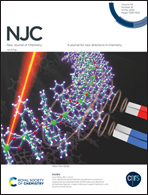Effect of surface defects on the interaction of the oxygen molecule with the ZnO(10![[1 with combining macron]](https://www.rsc.org/images/entities/char_0031_0304.gif) 0) surface†
0) surface†
Abstract
We study the interactions of the O2 molecule with stoichiometric and reduced ZnO(10![[1 with combining macron]](https://www.rsc.org/images/entities/char_0031_0304.gif) 0) surfaces by means of density functional theory calculations. We find that the O2 molecule can strongly interact with ZnO(10
0) surfaces by means of density functional theory calculations. We find that the O2 molecule can strongly interact with ZnO(10![[1 with combining macron]](https://www.rsc.org/images/entities/char_0031_0304.gif) 0) surfaces that have either O or Zn–O dimer vacancy defects. A strong ZnO–O2 interaction leads to the elongation of the O–O bond of the adsorbed O2 molecule. The trend of the O2 dissociation energy is the following: stoichiometric surface > Zn vacancy > Zn–O dimer vacancy > O vacancy. The results from the kinetic simulation are consistent with the trend of the O2 dissociation energy. The concentration of adsorbed atomic oxygen in the system with lower O2 dissociation energy will start to rise in a lower temperature region than in the system with higher O2 dissociation energy. The presence of adsorbed atomic oxygen is very important for the sensing mechanism of a ZnO-based resistive gas sensor. Based on our results, we propose a strategy to increase the concentration of adsorbed atomic oxygen on the ZnO(10
0) surfaces that have either O or Zn–O dimer vacancy defects. A strong ZnO–O2 interaction leads to the elongation of the O–O bond of the adsorbed O2 molecule. The trend of the O2 dissociation energy is the following: stoichiometric surface > Zn vacancy > Zn–O dimer vacancy > O vacancy. The results from the kinetic simulation are consistent with the trend of the O2 dissociation energy. The concentration of adsorbed atomic oxygen in the system with lower O2 dissociation energy will start to rise in a lower temperature region than in the system with higher O2 dissociation energy. The presence of adsorbed atomic oxygen is very important for the sensing mechanism of a ZnO-based resistive gas sensor. Based on our results, we propose a strategy to increase the concentration of adsorbed atomic oxygen on the ZnO(10![[1 with combining macron]](https://www.rsc.org/images/entities/char_0031_0304.gif) 0) surface. Theoretically, our results suggest that the sensing performance of ZnO-based sensors could be improved if one could increase the amount of not only the surface O vacancies but also the surface Zn–O dimer vacancies, while at the same time suppressing the presence of surface Zn vacancies. We find that the required criteria could be achieved by forming the surface under Zn-rich conditions. In such conditions, the formation energy of a Zn vacancy becomes relatively higher than the formation energies of an O vacancy and Zn–O dimer vacancy.
0) surface. Theoretically, our results suggest that the sensing performance of ZnO-based sensors could be improved if one could increase the amount of not only the surface O vacancies but also the surface Zn–O dimer vacancies, while at the same time suppressing the presence of surface Zn vacancies. We find that the required criteria could be achieved by forming the surface under Zn-rich conditions. In such conditions, the formation energy of a Zn vacancy becomes relatively higher than the formation energies of an O vacancy and Zn–O dimer vacancy.
![Graphical abstract: Effect of surface defects on the interaction of the oxygen molecule with the ZnO(10 [[1 with combining macron]] 0) surface](/en/Image/Get?imageInfo.ImageType=GA&imageInfo.ImageIdentifier.ManuscriptID=C9NJ06338B&imageInfo.ImageIdentifier.Year=2020)


 Please wait while we load your content...
Please wait while we load your content...
![[1 with combining macron]](https://www.rsc.org/images/entities/h2_char_0031_0304.gif) 0) surface
0) surface